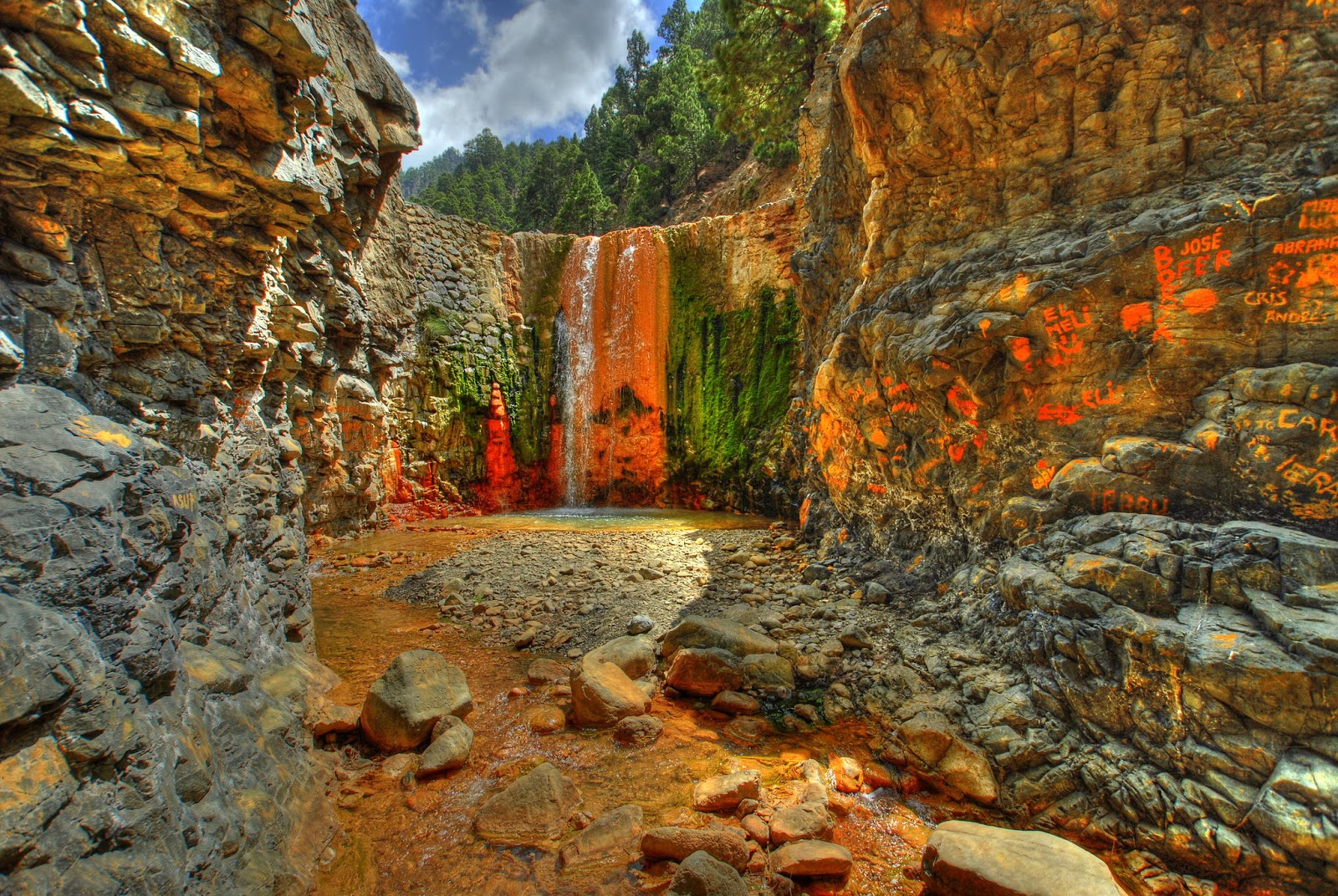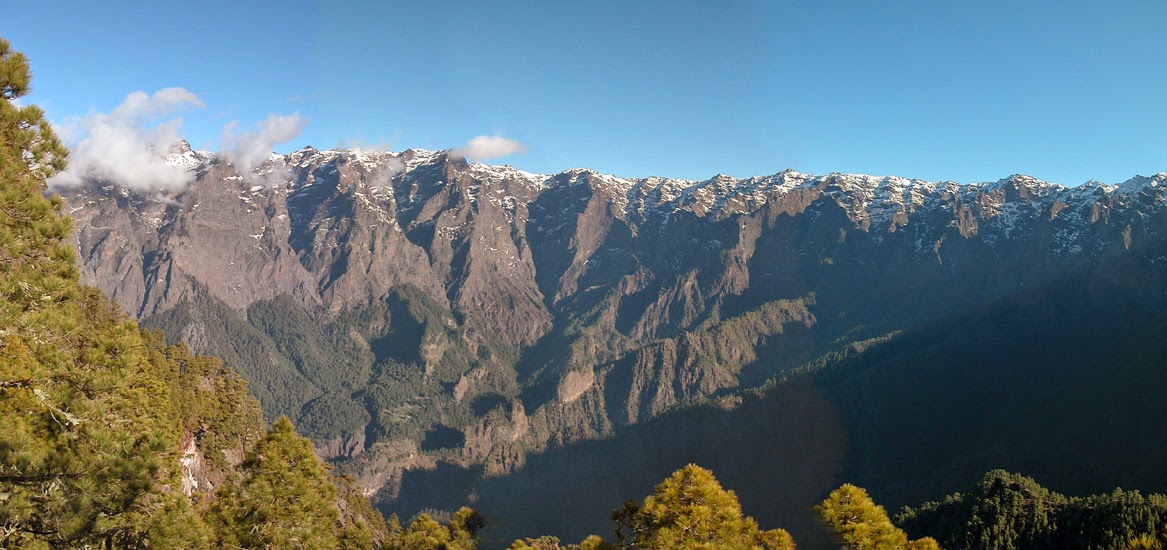La Palma is also called “Isla Bonita”, the “beautiful island”. Why this is so, one can best understand on a visit in the green heart of the island, the National Park “Parque Nacional de La Caldera de Taburiente”. It is one of Spain’s oldest national parks and in 2002, the park along with the entire island was designated as a World Biosphere Reserve. The depression was originated about two million years ago and, just like the rest of the island, it has a volcanic origin. The “Caldera de Taburiente” also has a special place in the history of the Canary Islands, because it was the place with the strongest resistance against the Spanish conquerors in the 15th century. At that time, La Palma or “Benahoare” (“my land”), as the island was called by the Aborigines, was divided into twelve kingdoms (“cantones”), each governed by a chief (“mencey”). The natives of La Palma were mainly goatherds and collected fruits and roots with which they made a kind of flour known as “gofio”. In 1492 the conquest of the island began under the leadership of Alonso Fernández de Lugo.
La Palma wird auch “Isla Bonita”, die “schöne Insel” genannt. Warum das so ist, versteht man am Besten bei einem Besuch im grünen Herzen der Insel, dem Nationalpark “Parque Nacional de La Caldera de Taburiente”. Es ist einer der ältesten Nationalparks Spaniens und 2002 wurde der Park mitsamt der ganzen Insel als Weltbiosphärenreservat ernannt. Vor ungefähr zwei Millionen Jahren entstand diese kraterähnliche Vertiefung die, genau wie der Rest der Insel, einen vulkanischen Ursprung hat. Auch in der kanarischen Geschichte hat die “Caldera de Taburiente” einen speziellen Platz, denn in der Caldera formierte sich der stärkste Wiederstand gegen die spanischen Eroberer im 15. Jahrhundert. Zu dieser Zeit war La Palma oder “Benahoare” (“mein Land”), wie die Insel von den Aborigenes genannt wurde, in zwölf Reiche (“cantones”) aufgeteilt, die jeweils von einem Oberhaupt (“mencey”) regiert wurden. Die Ureinwohner von La Palma waren hauptsächlich Ziegenhirten und sammelten Früchte und Wurzeln mit denen sie eine Art Mehl, bekannt als “gofio”, herstellten. Im Jahr 1492 begann die Eroberung der Insel unter der Führung von Alonso Fernández de Lugo.
La Palma también se conoce como la “Isla Bonita”. Por qué esto es así, se puede entender mejor en una visita en el corazón verde de la isla, el Parque Nacional de La Caldera de Taburiente. Es uno de los parques nacionales más antiguos de España y en 2002, el parque junto con el resto de la isla fue declarado Reserva Mundial de la Biosfera. Hace unos dos millones de años, se originó esta depresión que, al igual que el resto de la isla, tiene origen volcánico. La Caldera de Taburiente también ocupa un lugar especial en la historia de Canarias, ya que en la caldera tuvo lugar la resistencia más fuerte contra los conquistadores españoles en el siglo XV. En ese momento, La Palma o “Benahoare” como era llamada por los aborígenes (lo que significa “mi tierra”) estaba dividida en doce “cantones”, cada uno gobernado por un “mencey”. Los aborígenes de La Palma eran fundamentalmente pastores y recolectaban frutos y raíces con las que elaboraban una especie de harina, conocida como “gofio”. En 1492 comenzó la conquista de la isla bajo la dirección de Alonso Fernández de Lugo.
With the use of contracts and agreements the Spanish conquerors brought most “cantones” under their control. But the kingdom “Aceró” (“strong and invulnerable place”), which was located in the “Caldera de Taburiente”, was opposed to the Spanish invasion until the end. The Spaniards suggested the signing of a pecae treaty to the “mencey” of Aceró, who was called Tanausú. But it was an ambush in which Tanausú and his confidants were captured. The legend says that during the travel to the mainland Tanausú committed suicide by stopping to eat as a protest against the betrayal of the Spaniards. Today, the National Park is a paradise for hikers and nature enthusiasts. The beautiful scenery has spectacular height differences, large pine forests and lovely hiking trails for different levels of difficulty. However, the true protagonist of the National Park is the water that has its origin in the rain and the many underground springs. It flows trough small streams and waterfalls until it reaches the sea. An excursion to the “Caldera de Taburiente” is something you should definitely plan during your holidays on La Palma! Of course you can also stay in one of our newly renovated holiday houses directly in the National Park: Villa El Pinar, a luxurious country house with indoor pool and great comfort, and Casa Roberto, a charming stone house with Canarian flair.
Mithilfe von Verträgen und Abmachungen gelang es dem Spanier die meisten “cantones” unter seine Kontrolle zu bringen. Doch das Reich “Aceró” (“starker und unverwundbarer Ort”), das sich in der “Caldera de Taburiente” befand, setzte sich den spanischen Eroberern bis zum Ende entgegen. Die Spanier schlugen dem Oberhaupt von “Aceró”, Tanausú, die Unterzeichnung eines Friedenvertrags vor. Doch es handelte sich um einen Hinterhalt in dem Tanausú und seine Vertrauten gefangen genommen wurden. Die Legende erzählt das Tanausú sich aus Protest während der Fahrt auf das Festland zu Tode hungerte. Heutzutage ist der Nationalpark ein Paradies für Wanderer und Naturbegeisterte. Die wunderschöne Landschaft bietet spektakuläre Höhenunterschiede, große Pinienwälder und spektakuläre Wanderwege für verschiedene Schwierigkeitsgrade. Der wahre Protagonist des Nationalparks ist jedoch das Wasser, das seinen Ursprung im Regen und den vielen unterirdischen Quellen hat und kleine Bäche und Wasserfälle bildet bis es durch die Barrancos bis zum Meer fließt. Bei einem Besuch auf La Palma ist die “Caldera de Taburiente” ein perfektes Ausflugsziel! Natürlich können Sie auch in einem unserer neu renovierten Ferienhäuser direkt im Nationalpark wohnen: Villa El Pinar, ein luxuriöses Landhaus mit Innenpool und großem Komfort, und Casa Roberto, ein charmantes Steinhaus mit kanarischem Flair.
Mediante una serie de contratos y acuerdos, los españoles lograron someter a una gran parte de los cantones. Pero el cantón “Aceró” (“lugar fuerte e invulnerable”), que se encontraba en la Caldera de Taburiente, se opuso al dominio español hasta el final. Los españoles sugirieron al mencey de Aceró, llamado Tanausú, la firma de un tratado de paz. Pero fue una emboscada en la que Tanausú y sus confidentes fueron capturados. La leyenda cuenta que durante el viaje a la Penísula Tanausú se suicidió dejando de comer como símbolo contra la traición de los españoles. Hoy en día, el Parque Nacional es un paraíso para excursionistas y amantes de la naturaleza. Los hermosos paisajes cuentan con impresionantes cambios de altura, grandes bosques de pinos canarios y espectaculares senderos con diferentes niveles de dificultad. Sin embargo, el verdadero protagonista de este Parque Nacional es el agua, que tiene su origen en la lluvia y los numerosos manantiales subterráneos y que a través de pequeños arroyos, cascadas y barrancos fluye hacia el mar. ¡Una excursión a la “Caldera de Taburiente” es algo imprescindible es sus vacaciones en la isla! Por supuesto, también puede alojarse en una de nuestras casas vacacionales recién renovadas directamente en el Parque Nacional: Villa El Pinar, una casa de campo de lujo con piscina cubierta y un gran confort, y Casa Roberto, una casa tradicional de piedra con un toque canario.
 |
| Villa El Pinar, La Palma |


